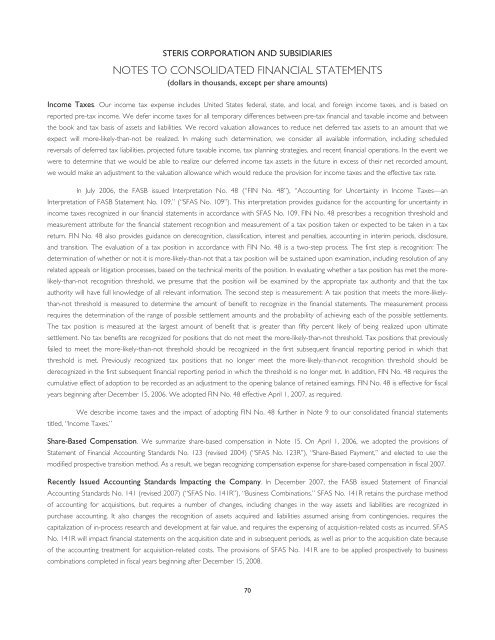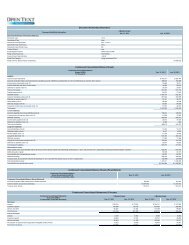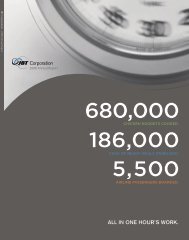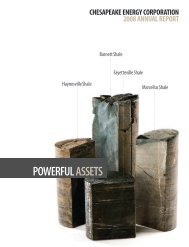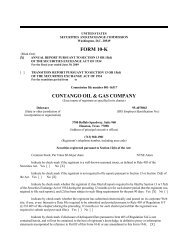On the Surface
On the Surface
On the Surface
Create successful ePaper yourself
Turn your PDF publications into a flip-book with our unique Google optimized e-Paper software.
STERIS CORPORATION AND SUBSIDIARIES<br />
NOTES TO CONSOLIDATED FINANCIAL STATEMENTS<br />
(dollars in thousands, except per share amounts)<br />
Income Taxes. Our income tax expense includes United States federal, state, and local, and foreign income taxes, and is based on<br />
reported pre-tax income. We defer income taxes for all temporary differences between pre-tax financial and taxable income and between<br />
<strong>the</strong> book and tax basis of assets and liabilities. We record valuation allowances to reduce net deferred tax assets to an amount that we<br />
expect will more-likely-than-not be realized. In making such determination, we consider all available information, including scheduled<br />
reversals of deferred tax liabilities, projected future taxable income, tax planning strategies, and recent financial operations. In <strong>the</strong> event we<br />
were to determine that we would be able to realize our deferred income tax assets in <strong>the</strong> future in excess of <strong>the</strong>ir net recorded amount,<br />
we would make an adjustment to <strong>the</strong> valuation allowance which would reduce <strong>the</strong> provision for income taxes and <strong>the</strong> effective tax rate.<br />
In July 2006, <strong>the</strong> FASB issued Interpretation No. 48 (“FIN No. 48”), “Accounting for Uncertainty in Income Taxes—an<br />
Interpretation of FASB Statement No. 109,” (“SFAS No. 109”). This interpretation provides guidance for <strong>the</strong> accounting for uncertainty in<br />
income taxes recognized in our financial statements in accordance with SFAS No. 109. FIN No. 48 prescribes a recognition threshold and<br />
measurement attribute for <strong>the</strong> financial statement recognition and measurement of a tax position taken or expected to be taken in a tax<br />
return. FIN No. 48 also provides guidance on derecognition, classification, interest and penalties, accounting in interim periods, disclosure,<br />
and transition. The evaluation of a tax position in accordance with FIN No. 48 is a two-step process. The first step is recognition: The<br />
determination of whe<strong>the</strong>r or not it is more-likely-than-not that a tax position will be sustained upon examination, including resolution of any<br />
related appeals or litigation processes, based on <strong>the</strong> technical merits of <strong>the</strong> position. In evaluating whe<strong>the</strong>r a tax position has met <strong>the</strong> morelikely-than-not<br />
recognition threshold, we presume that <strong>the</strong> position will be examined by <strong>the</strong> appropriate tax authority and that <strong>the</strong> tax<br />
authority will have full knowledge of all relevant information. The second step is measurement: A tax position that meets <strong>the</strong> more-likelythan-not<br />
threshold is measured to determine <strong>the</strong> amount of benefit to recognize in <strong>the</strong> financial statements. The measurement process<br />
requires <strong>the</strong> determination of <strong>the</strong> range of possible settlement amounts and <strong>the</strong> probability of achieving each of <strong>the</strong> possible settlements.<br />
The tax position is measured at <strong>the</strong> largest amount of benefit that is greater than fifty percent likely of being realized upon ultimate<br />
settlement. No tax benefits are recognized for positions that do not meet <strong>the</strong> more-likely-than-not threshold. Tax positions that previously<br />
failed to meet <strong>the</strong> more-likely-than-not threshold should be recognized in <strong>the</strong> first subsequent financial reporting period in which that<br />
threshold is met. Previously recognized tax positions that no longer meet <strong>the</strong> more-likely-than-not recognition threshold should be<br />
derecognized in <strong>the</strong> first subsequent financial reporting period in which <strong>the</strong> threshold is no longer met. In addition, FIN No. 48 requires <strong>the</strong><br />
cumulative effect of adoption to be recorded as an adjustment to <strong>the</strong> opening balance of retained earnings. FIN No. 48 is effective for fiscal<br />
years beginning after December 15, 2006. We adopted FIN No. 48 effective April 1, 2007, as required.<br />
We describe income taxes and <strong>the</strong> impact of adopting FIN No. 48 fur<strong>the</strong>r in Note 9 to our consolidated financial statements<br />
titled, “Income Taxes.”<br />
Share-Based Compensation. We summarize share-based compensation in Note 15. <strong>On</strong> April 1, 2006, we adopted <strong>the</strong> provisions of<br />
Statement of Financial Accounting Standards No. 123 (revised 2004) (“SFAS No. 123R”), “Share-Based Payment,” and elected to use <strong>the</strong><br />
modified prospective transition method. As a result, we began recognizing compensation expense for share-based compensation in fiscal 2007.<br />
Recently Issued Accounting Standards Impacting <strong>the</strong> Company. In December 2007, <strong>the</strong> FASB issued Statement of Financial<br />
Accounting Standards No. 141 (revised 2007) (“SFAS No. 141R”), “Business Combinations.” SFAS No. 141R retains <strong>the</strong> purchase method<br />
of accounting for acquisitions, but requires a number of changes, including changes in <strong>the</strong> way assets and liabilities are recognized in<br />
purchase accounting. It also changes <strong>the</strong> recognition of assets acquired and liabilities assumed arising from contingencies, requires <strong>the</strong><br />
capitalization of in-process research and development at fair value, and requires <strong>the</strong> expensing of acquisition-related costs as incurred. SFAS<br />
No. 141R will impact financial statements on <strong>the</strong> acquisition date and in subsequent periods, as well as prior to <strong>the</strong> acquisition date because<br />
of <strong>the</strong> accounting treatment for acquisition-related costs. The provisions of SFAS No. 141R are to be applied prospectively to business<br />
combinations completed in fiscal years beginning after December 15, 2008.<br />
70


